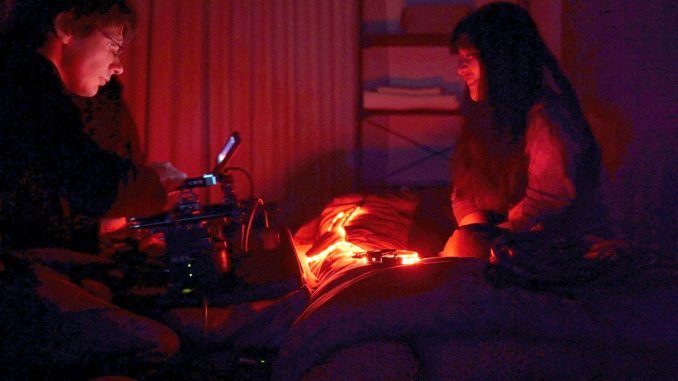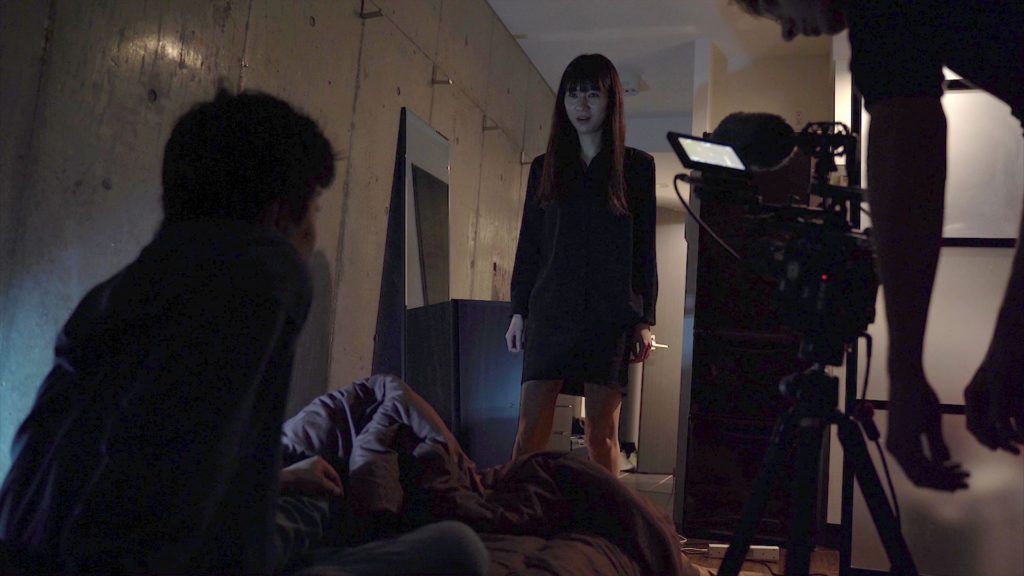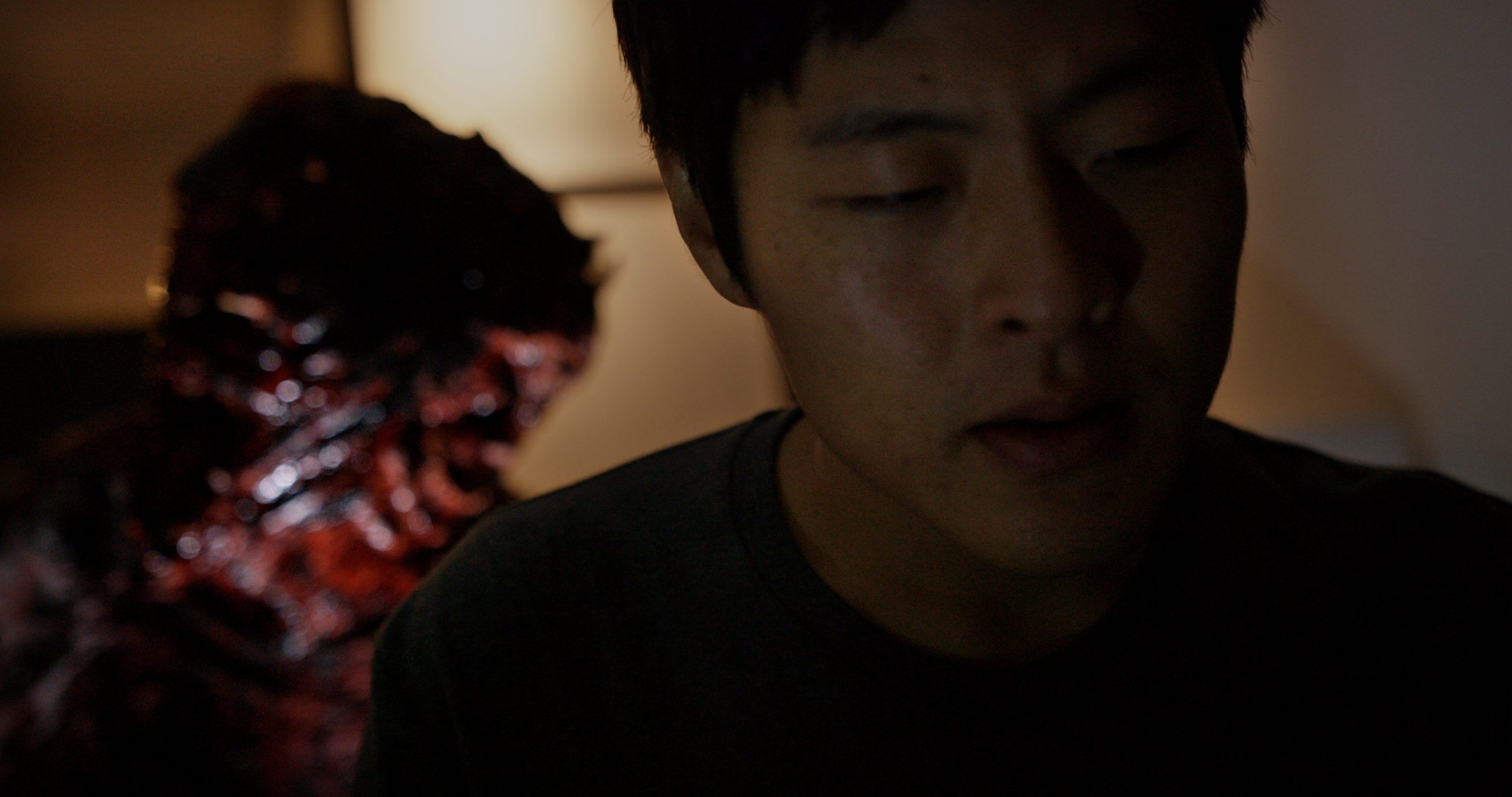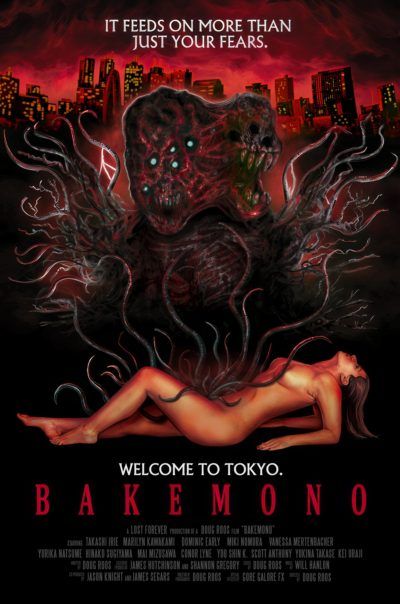
Doug Roos was born and grew up in Blue Springs, Missouri, and made his first short film when he was 12. He always wanted to be a film director, in particular after watching Aliens when he was way too young. Doug moved to China, and lived there for seven years, before travelling to Japan, because he had the dream of making a movie there, inspired by a love of Japanese culture, and films like Godzilla, Yojimbo, Sanjuro, Battle Royale. Despite being told by production companies it was impossible to make a low budget film there, he persisted – “That just encouraged me even more,” he said – and has now completed Bakemono, an all-practical effects feature about the Airbnb from hell. Literally…
The director spoke to us about the true-life inspirations for Bakemono, the joy (and peril!) of practical effects, and having to finish shooting before the last train.
This isn’t your first feature. What came before Bakemono, and what were the biggest lessons learned in the process?
The Sky Has Fallen was my first feature, back in 2006 when I was 22 years old. It was shot on my aunt and uncle’s land in rural Missouri: a post-apocalyptic bloodbath inspired by the Japanese film Versus. It had all practical FX with a katana-wielding anti-hero and black demonic figures experimenting on the dead, turning them into Fulci-esque bladed creatures. Then I made my second feature Rearranged in Shanghai, China. I haven’t released that one yet: COVID kind of messed up my plans. It’s an indie sci-fi film with a touch of horror – I can’t help it! Plus, I directed 22 short films and have a lot of producing credits on stuff like Night of the Living Deb, Fonotune, Remember You, Gehenna: Where Death Lives, etc.
“Always challenge yourself to do more, and never give up.”
Biggest lessons learned would have to be, to give yourself plenty of time if you’re doing a lot of practical FX, always challenge yourself to do more, and never give up. I think you have to stay true to yourself too and make personal films that take risks that you really care about. Otherwise, there’s no point.
What inspired this film?
The Thing was the main inspiration but actually, many of the side stories are true experiences told to me: the crazy neighbor yelling at inanimate objects was overheard by a Chinese friend of mine here in Tokyo (the neighbor was a Japanese girl in her 20s who lived alone). We have a crazy neighbor right now who messes with the door 20 times before leaving her apartment. This is strangely common here, with Chris Broad talking about a similar experience in one of his YouTube videos. “Can’t have a BBQ without a man,” was said to that actress when she was with friends. The Japanese guy repeatedly declining the pretty girl really happened to that model. It’s a frequent occurrence with foreign girls here; they have to be the aggressive one. Even the innocent schoolgirl offering help is a story straight out of the news here. It was a younger drunk guy instead, but she asked if he needed help and he sexually assaulted her.
I wanted the main character to emerge little by little during the first act, until you realize who he is 40 minutes in – Hitchcock was a big influence on this. Actually, the main character is right there in the opening scene, but people might not notice. He’s a mystery at first, and only later, can you understand. A key sequence 40 minutes in, actually takes place chronologically at the beginning of the story. There are many characters, since I was going for a Battle Royale vibe, though I think it has far more characters!
 It gave me a “Lovecraft crossed with Shinya Tsukamoto” vibe. Was that intentional?
It gave me a “Lovecraft crossed with Shinya Tsukamoto” vibe. Was that intentional?
Absolutely, and that is a huge compliment to me. Thank you so much! I love Shinya Tsukamoto and I’ve seen all of his films. I don’t think I’m anywhere near his level, obviously, but I think the way we make movies is actually quite similar, since he does so much himself and takes a lot of time filming. I’m a huge Lovecraft fan too and I love Stuart Gordon’s adaptations like From Beyond, Dagon, his Masters of Horror episode “Dreams in the Witch House,” etc.
Why did you go for practical effects over CGI, and what challenges did that pose?
I just love practical FX so much. It’s what I grew up on and I think it’s far more effective, especially in horror. Actors really have something to respond to, so they can give better performances and I think the audience can feel something is really there. To me, there is no substitute and I refuse to use CGI. I can’t deny that CGI is amazing in the first Jurassic Park and Starship Troopers, or that a combination of CGI with practical FX can be incredible. It’s a tool like any other, but I think it’s just abused now, so the magic is gone. I loved Discovery Channel’s Movie Magic show as a child, and I want to make monsters come to life. That is so exciting to me. I want to design them with a pencil, sculpt them with my hands, create the molds and gelatin masks, apply the blood, etc. I love all that.
“I want to make monsters come to life… I want to design them with a pencil, sculpt them with my hands, create the molds and gelatin masks, apply the blood.”
It can be insanely difficult. I’ve got behind the scenes footage of me sitting there, with my foot in a box to move part of one creature, with the other piece of it in my left hand to make it jump, as I focus the RED with my right hand. Since I’m usually doing everything by myself, it’s very challenging. I was building up stuff with a hot glue gun I bought at a dollar store here. We shot for over 80 days because I knew the practical FX would take so much time. But I warned everyone about that in advance and I was the only person doing all those days. The most for other people would be 14 or 7 days depending on the group. So that was tiring, and the monster requires constant touch-ups to make sure it still looks good. Plus, it was difficult to figure out how to do some of the FX, like when one of the mutations shoots out spikes. I would do it again in a heartbeat though.
Was casting a challenge?
Definitely but I got really lucky when Takashi Irie emailed me. I saw this trailer for a short where he was a loving father, but I just knew he’d be perfect and he really was. He had so much experience too and sometimes I’d let a take keep rolling just to see what he would do because he was that good. I feel like he’s my secret weapon in this movie, on the same level of an Anthony Hopkins or Anthony Perkins. He really is amazing in this film. One time I wanted to go back and do more, just because some lighting had bothered me. He was completely game. He told me he would do anything as long as the film was good and that’s exactly how I felt too.
I just want to make the most phenomenal movies I can, and whatever hell I have to go through to do that, I will. But, really, the actors were wonderful. They gave it everything they had and it’s not easy with the blood, waiting on FX, trying to get everything right, etc. But I think finding the right people is always tough. Dominic, one of my actors, actually helped me find two other actors for key roles, so I was very grateful to him.
How was the shoot in general?
It was almost all night shoots but we could only shoot until the last train, around midnight, or else taxis would be crazy expensive. While the total was 80 days for myself, we didn’t shoot a large amount of hours every day: no 12-hour days or anything. I think it was usually 6pm to 11pm or so. When I was by myself doing stuff, I would go all day. I was pretty exhausted and stressed about all the FX, but I think spirits were high for most of the cast.
Near the end of filming, COVID became a pandemic, and as one actress had to leave pretty quickly, we shot her part in just 4 or 5 days. Those days were long, but that was the exception. One actor also got trapped in the US because of COVID and wasn’t able to return to Japan until many months later. We weren’t even sure he could come back, but thankfully he was able to, and then we filmed his role. Luckily, most of the filming was done before COVID really became such a nightmare, but it did interfere a bit near the end.
Purely from a lighting perspective, it’s a very “dark” movie, almost everything taking place in deep shadow. What were the reasons for that choice?
I really love atmospheric horror films with a sense of dread, so I was trying to create that. I think Lovecraft’s fear of the unknown is very powerful in the dark, since you never know what could be hiding in the shadows. Also, since it’s all about the dark side of Tokyo, I thought it made perfect sense. I love the dark too, and that contrast with the light. But I tried to show a whole range of light to dark with the bathroom scenes being quite bright, the shower less bright (matching his situation), some parts a little dark, others very dark, characters walking in and out of light, and everything in between.
I love playing with all that, but especially darkness and exploring that with a little light here or there, or reflecting in someone’s eyes. My favorite is candlelight but it has to be augmented depending on the shot. It’s tricky to make that addition look natural especially if someone is wearing black in a dark environment. I think lighting is critical in horror though, and I love that fine line. Roger Deakins is a huge inspiration to me, especially that shot in Sicario at late sunset, where they all walk down into darkness, disappearing into it.
 It’s clearly more than just a monster movie. What’s going on beneath the surface?
It’s clearly more than just a monster movie. What’s going on beneath the surface?
The monster is a metaphor for the dark side of Tokyo. Those elements include:
- Rape – all countries have rape but Japan actually has a character called “Rapeman” with a manga, anime, and 8 live-action films.
- Overwork – still a big deal in Japan, with an NHK reporter in his 40s dying from a crazy level of overtime in 2019, plus a 31-year-old female NHK reporter died of the same cause in 2013, and many other cases.
- Gender roles – if a woman is too independent and strong-willed here, people will say she is like a man, since they think women can’t be that way… it’s nuts.
- Infidelity – a Japanese book my wife read, showed the level is much higher here than the US or China, almost on par with France.
- Xenophobia, stress, suicide, isolation, alcoholism, discrimination toward “half” Japanese, etc.
All the characters talk about these social issues. This is what the underlying story is really about, and it’s also why the monster psychologically affects the weak. The city of Tokyo does the same thing, making people more competitive and cold, stressed, etc. plus the monster is hidden, just like the dark side of Tokyo.
“I just want to make the most phenomenal movies I can, and whatever hell I have to go through to do that, I will.”
The characters reflect the societal makeup of Tokyo: salaryman, schoolgirl, ojisan, Japanese dating couple, English teacher, Korean, etc. Very few films reflect the diversity of people in Tokyo. I myself have been living here for 6 years now, but there are many who have been here 20 years or more. plus generations of Koreans, etc.All the foreigners in the film actually live in Japan, doing the same jobs as their characters. I’ve watched so many Japanese films but it’s extremely rare to see a foreigner speaking Japanese in one, and very few show the foreigners who live here.
The film also has more layers of meaning, such as the consequences of rape and the danger of ego. I’m trying to avoid spoilers but I wanted there to be several levels to the story and ways you could look at it. I don’t want to make a movie unless it really means a lot to me, and has many different things going on beneath the surface, because it’s very difficult. It takes so much time – years really – and costs so much money, all my own, etc. It has to be a passion project for me and something I care deeply about. All three of my features have been this way.
What has the local reaction to the film been like?
I only had a private cast screening here in Tokyo, with a few friends invited as well, so I’m not sure yet. I did do anonymous feedback surveys and those were quite positive, but that group is still biased in my favor. I’m very excited to see what Japanese horror fans think of it; I don’t know if I’ll show it in a theater here or not. A distributor I met here thought I could put it in Tokyo theaters, but I didn’t think that was possible. However, some companies here now are putting low budget horror into theaters so we’ll see.
How is the low-budget horror scene in Tokyo?
I definitely think the best ones are exported such as One Cut of the Dead, the Sushi Typhoon films, etc. Many lackluster local ones don’t make it abroad, but sometimes there are undiscovered gems that slip through the cracks. I love Guzoo: The Thing Forsaken By God Part 1 from 1986. It’s not perfect but it’s practical FX and it’s the closest Japan got to The Thing. I also love Cyclops (1987), which did get a Blu-ray in Europe but not the US. It seems the low-budget horror scene isn’t doing so well here nowm since often the Japanese films only have 3-5 days to shoot with the tiniest of budgets (like $10k). It’s nearly impossible to make great films that way, and it’s a shame since there are many talented directors – but they don’t give them any time or money.
What’s next?
Another really crazy monster movie. It’s going to be very hard to shoot, but I can’t wait. It’s another one, all on my own. and a big challenge with a ton of practical FX, nudity, etc. It was inspired by another news story I read here, along with some other influences. I am still also shooting more practical FX for the exclusive crowdfunding-only cut of Bakemono, which people can get here. Crowdfunding is the main way I recoup all the money I spent, so that really helps a lot and I try to have really special rewards too.

Bakemono (2023)
Rating: B-
Dir: Doug Roos
Star: Takashi Irie, Marilyn Kawakami, Dominic Early, Miki Nomura
I don’t think we’ll be renting an apartment in Tokyo any time soon, between the deficient lighting and the creepy caretakers. Oh, and the demonic activity. That may be the abiding takeaway from this grimy, tenticular little effort by Roos, an American living in Japan. It acts as an energetic counterpoint to the usual depiction of the city as a neon-drenched metropolis, instead largely taking place in a shadowy gloom which is oppressive to the point of overwhelming. Things unfold largely in a low-rent apartment building, inhabited by a series of transients, most of whom are there for a short time, rather than a good time. [Basically an AirBNB] For instance, Chris (Early) is in Tokyo on a teaching assignment, which has taken him away from his wife and daughter.
It’s a dingy set of cramped accommodations, the kind of place in which nobody would really spend time out of choice. In charge is Mitsuo (Irie), who seems to be weird from the get-go. Such concerns prove amply justified, because it turns out, he is a big fan of the occult, and summoned a demon into the apartment building. Quite why, remains largely opaque. However, it is not exactly helping his host rating, both by attacking residents directly, and by triggering them to act out violently against each other. It’s a monster in every sense: the director said he was inspired by The Thing, and this critter would seem quite at home in the Antarctic. Or Innsmouth, for there’s brooding, Lovecraftian menace here to spare.
 I do wish we could see a bit more of what was going on. One of the most effective elements of The Thing, was John Carpenter’s refusal to hide the monster. I love how it is right there in front of you, under the harsh fluorescent light, almost mocking the “leave things to the viewer’s imagination” theory. Here, you rarely get to experience the monster in its glorious, well-lit entirety. Instead, it feels as if every resident’s primary focus is less survival, than saving money on their electricity bill. This is a pity, since what we see looks good, and demonstrates conclusively that low-budget practical FX are always going to be superior to low-budget CGI.
I do wish we could see a bit more of what was going on. One of the most effective elements of The Thing, was John Carpenter’s refusal to hide the monster. I love how it is right there in front of you, under the harsh fluorescent light, almost mocking the “leave things to the viewer’s imagination” theory. Here, you rarely get to experience the monster in its glorious, well-lit entirety. Instead, it feels as if every resident’s primary focus is less survival, than saving money on their electricity bill. This is a pity, since what we see looks good, and demonstrates conclusively that low-budget practical FX are always going to be superior to low-budget CGI.
The performances are surprisingly strong. I say “surprisingly” because I am painfully aware how low-budget cinema frequently involves using the actors you can get, rather than the ones you need. The results tend. for example, to have people as gangsters who are patently not gangsters. Here though, while there are varying degrees of experience, most are residents of Tokyo, playing… residents of Tokyo. Not much of a stretch – yet as ever, it’s all about knowing how to work within your resource limitations. The one doing most “acting” is likely Irie, and his performance is impressive, consistently unsettling from almost the first time we see him.
That said, there’s perhaps too much going on. It follows a slew of inhabitants, and it’s unclear whether all their threads are going on concurrently or consecutively. Less, such as telling Chris’s story in greater detail, might have been more, and Roos’s decision to tell things out of order, didn’t feel like it added much – except some initial confusion! However, it remains a fascinating, likely unique viewing experience, and a fine example of doing a lot with a little. It certainly operates as a very nice contrast to Godzilla: Minus One. In Tokyo, monsters come in all shapes and sizes…
The film premiered at the San Francisco Another Hole in the Head Film Festival on December 9th, and will then go on the festival circuit. He’s still raising money for it, if you feel like chipping in.
